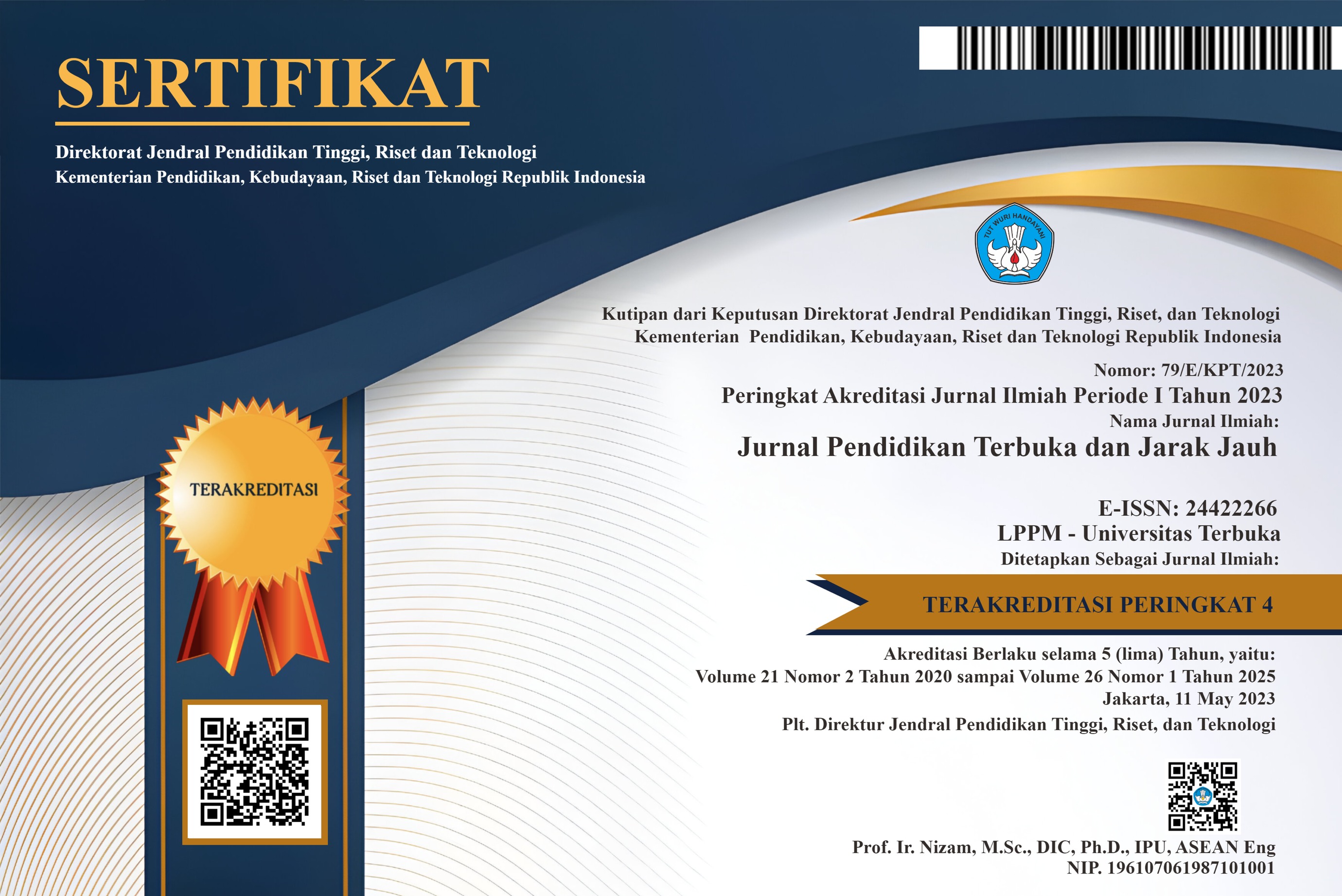GAYA BELAJAR DAN STRATEGI BELAJAR MAHASISWA UNIVERSITAS TERBUKA UNIT PROGRAM BELAJAR JARAK JAUH MEDAN
Keywords:
learning strategy, learning styleAbstract
Several researches on learning styles and learning strategies had been conducted at Universitas Terbuka (UT. It had found out that students tend to have visual learning style. Different learning styles and learning strategies might be happened in students at each regional office due to the influence of local ethnicity. This article was written based on a research conducted to determine the tendency of students' learning styles and strategies at the Regional Center (UPBJJ-UT) Medan compared to UTs students' learning styles and strategies in general. Comparition was also done between exacta students and non-exacta students in the UPBJJ-UT Medan. Data were collected through questionnaire and analyzed with descriptive method. The findings showed that: (1) the students learning styles at the UPBJJ-UT Medan tend to be similar with the students of UT in general, which was visual learning style; (2) there were different learning styles between exacta students and non-exacta students; (3) students learning strategies at the UPBJJ-UT Medan have not been effective. It was suggested that UPBJJ-UT Medan should help students by developing a handbook or manual of self-learning strategies which could be socialized continuously at the New Student Orientation Study (OSMB) and through the web site.
References
Ebel, R.L., & Frisbie, D.A. (1986). Essensials of educational measurement. (4th. ed). New Jersey: Prentice Hall, inc.
Julaeha, S. (2002). Memahami gaya dan strategi belajar mahasiswa. Jurnal Pendidikan Terbuka dan Jarak Jauh, 3 (2), 1-15.
Nugraheni, E. & Pangaribuan, N. (2006). Gaya belajar dan strategi belajar mahasiswa jarak jauh: Kasus di Universitas Terbuka. Jurnal Pendidikan Terbuka dan Jarak Jauh, 7 (1), 68-82.
Phibin, M., Meier, B., Huffman, S., & Bouverse, P. (1995). Survey of gender and learning styles. Sex Roles, 32, 484-494.
Putranti, N. (2007). Gaya belajar anda visual, auditori, atau kinestetik? Diambil tanggal 21 Februari 2011 dari http://webcache.googleusercontent.com/search?q=cache:LyyfL79iAJ: nuritaputranti.wordpress.com/2007/12/28/gayabelajarandavisualauditoriataukinestetik/+gaya+belajar&cd=1&hl=id&ct=clnk&gl=id&client=firefox- a&source=www.google.co.id.
Prayudi, Y.Y. (2007). Gaya belajar individu. Diambil tanggal 21 Februari 2011 dari http://webcache.googleusercontent.com/search?q=cache:GjnqUpavT4EJ:prayudi.wordress.com/2007/11/27/gayabelajarindividu/+gaya+belajar&cd=11&hl=id&ct=clnk&gl=id&client=firefox-a&source=www.google.co.id.
Sahertian, C.D.W. (2004). Pengaruh penggunaan bahan ajar dan gaya belajar terhadap hasil belajar. Diambil tanggal 19 Februari 2011 dari http://artikel.us/-04.
Wyman, P. (2007). Gaya belajar. (Penerjemah Untung S Drazat). Diambil tanggal 21 Februari 2011 dari http://webcache.googleusercontent.com/search?q=cache:cacCkKYtPdsJ: toenks.blogspot.com/2007/10/gayabelajar.html+pola+bicara+dan+gaya+belajar&cd=3&hl=id&ct=clnk&gl=id&client=firefox-a&source=www.google.co.id.





